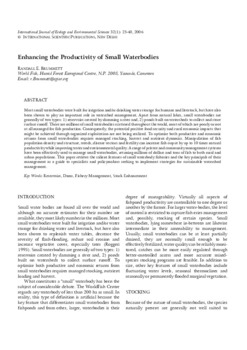Enhancing the productivity of small waterbodies

Citation
Brummett R.E. (2006). Enhancing the productivity of small waterbodies. International Journal of Ecology and Environmental Sciences, 32(1): 25-40
Most small waterbodies were built for irrigation and/or drinking water storage for humans and livestock, but have also been shown to play an important role in watershed management. Apart from natural lakes, small waterbodies are generally of two types: 1) reservoirs created by damming a river and, 2) ponds built on watersheds to collect and store surface runoff. There are millions of small waterbodies scattered throughout the world, most of which are poorly or not at all managed for fish production. Consequently, the potential positive food security and rural economic impacts that might be achieved through organized exploitation are not being realized. To optimise both productive and economic returns from small waterbodies requires managed stocking, harvest and nutrient dynamics. Manipulation of fish population density and structure, weeds, disease vectors and fertility can increase fish ouput by up to 10 times natural productivity while improving water and environmental quality. A range of private and community management systems have been effectively used to manage small waterbodies, retuning millions of dollars and tons of fish to both rural and urban populations. This paper reviews the salient features of small waterbody fisheries and the key principals of their management as a guide to specialists and policymakers seeking to implement strategies for sustainable watershed management.
Permalink
Date Available
Type
Publisher
Research Themes
Language